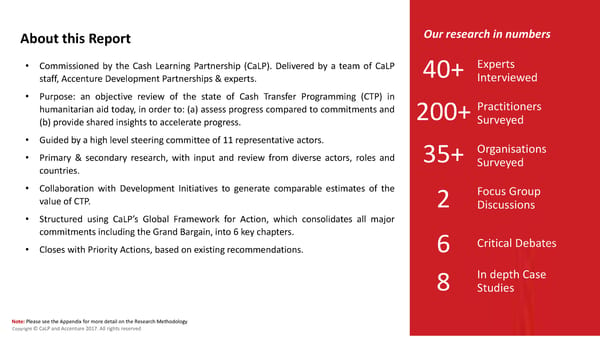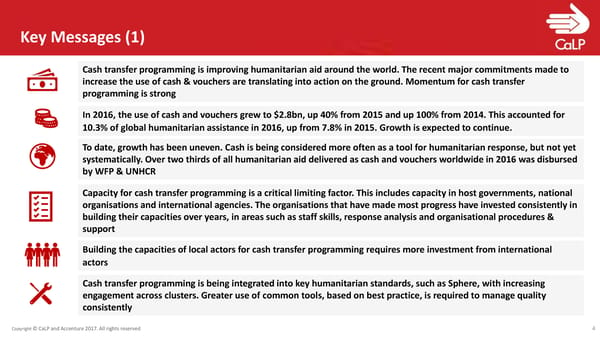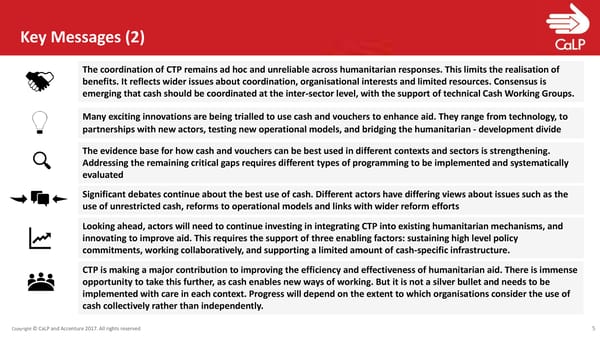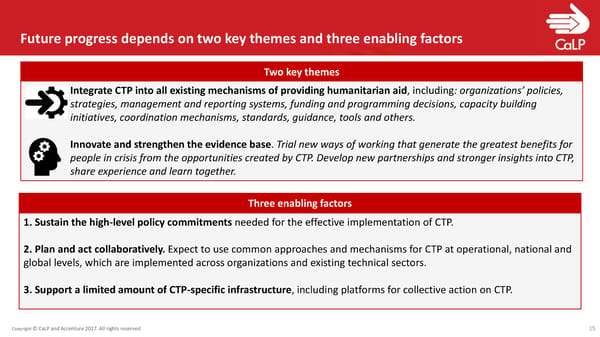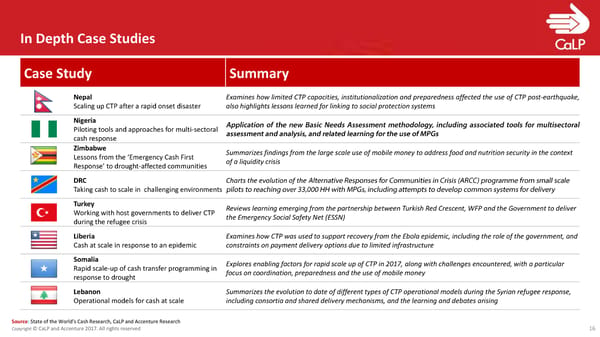State of World’s Cash Report | Presentation
State of World’s Cash Report: Cash transfer programming in humanitarian aid February 2018
About this Report Our research in numbers • Commissioned by the Cash Learning Partnership (CaLP). Delivered by a team of CaLP 40+ Experts staff, Accenture Development Partnerships & experts. Interviewed • Purpose: an objective review of the state of Cash Transfer Programming (CTP) in Practitioners humanitarian aid today, in order to: (a) assess progress compared to commitments and 200+ (b) provide shared insights to accelerate progress. Surveyed • Guidedbyahighlevelsteeringcommitteeof11representativeactors. Organisations • Primary & secondary research, with input and review from diverse actors, roles and 35+ Surveyed countries. • Collaboration with Development Initiatives to generate comparable estimates of the Focus Group value of CTP. 2 Discussions • Structured using CaLP’s Global Framework for Action, which consolidates all major commitmentsincludingtheGrandBargain,into6keychapters. 6 Critical Debates • Closes with Priority Actions, based on existing recommendations. 8 In depth Case Studies Note: Please see the Appendix for more detail on the Research Methodology Copyright © CaLPand Accenture 2017. All rights reserved 2
1 Global spend on cash & vouchers 2 CTP is being considered more often, but 3 Capacity for CTP is a limiting factor increased by 40% to $2.8bn in 2016 not systematically across organizations Total Cash and Voucher Aid CTP as a % of Total Global Sector experience with CTP Only Growth from 2015 to 2016 Hum. Aid of $27.3bn in 2016 Low High 87% 40% Food Organizations have enough 2016 2.8bn Respondents agree that CTP capacity to implement CTP 10.3% Shelter is more routinely considered WASH than a year ago Increment 40% Nutrition 7/10 Barriers to accessing CTP trainings 0.8 bn Education 48% Organizations do not agree Organizations Cost of Face to face trainings Health that market and response have difficulty 2015 2.0bn Protection analysis are embedded in finding skilled Lack of time to attend response staff for CTP roles The quality of CTP is improving, 5 The coordination of CTP is unreliable, Innovations and evidence are 4 enhanced by collaboration limiting the benefits realized 6 proliferating, but gaps remain Practitioners believe their organization % Practitioners who believe there has been an improvement in % Practitioners who believe evidence is available to Quality of CTP 100% - Has made progress towards Predictability of CTP Agree 8/10 increasing the quality of CTP 48%coordination 41%coordination 80% - Has considered evidence of best Practitioners believe that national/ local actors are 53% practices while designing and 28%appropriately involved in the coordination for CTP 44% implementing CTP Barriers to effective coordination for CTP 0% - Is taking steps to embed common Confusion about where CTP Limited commitment to Agree standards and guidelines for CTP coordination sits / no leadership use shared operational Use CTP Inform selection in the international system mechanisms Make the case for CTP appropriately of operational Source: Practitioner Survey, Organization Survey, CaLP and Accenture Research across sectors model for CTP Copyright © CaLPand Accenture 2017. All rights reserved
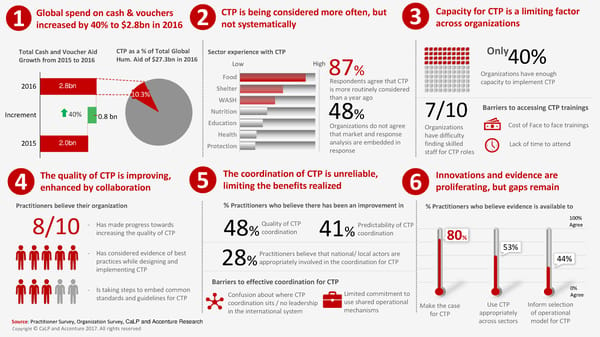
Key Messages (1) Cash transfer programming is improving humanitarian aid around the world. The recent major commitments made to increase the use of cash & vouchers are translating into action on the ground. Momentum for cash transfer programming is strong In 2016, the use of cash and vouchers grew to $2.8bn, up 40% from 2015 and up 100% from 2014. This accounted for 10.3% of global humanitarian assistance in 2016, up from 7.8% in 2015. Growth is expected to continue. To date, growth has been uneven. Cash is being considered more often as a tool for humanitarian response, but not yet systematically. Over two thirds of all humanitarian aid delivered as cash and vouchers worldwide in 2016 was disbursed by WFP & UNHCR Capacity for cash transfer programming is a critical limiting factor. This includes capacity in host governments, national organisations and international agencies. The organisations that have made most progress have invested consistently in building their capacities over years, in areas such as staff skills, response analysis and organisational procedures & support Building the capacities of local actors for cash transfer programming requires more investment from international actors Cash transfer programming is being integrated into key humanitarian standards, such as Sphere, with increasing engagement across clusters. Greater use of common tools, based on best practice, is required to manage quality consistently Copyright © CaLPand Accenture 2017. All rights reserved 4
Key Messages (2) The coordination of CTP remains ad hoc and unreliable across humanitarian responses. This limits the realisation of benefits. It reflects wider issues about coordination, organisational interests and limited resources. Consensus is emerging that cash should be coordinated at the inter-sector level, with the support of technical Cash Working Groups. Many exciting innovations are being trialled to use cash and vouchers to enhance aid. They range from technology, to partnerships with new actors, testing new operational models, and bridging the humanitarian - development divide The evidence base for how cash and vouchers can be best used in different contexts and sectors is strengthening. Addressing the remaining critical gaps requires different types of programming to be implemented and systematically evaluated Significant debates continue about the best use of cash. Different actors have differing views about issues such as the use of unrestricted cash, reforms to operational models and links with wider reform efforts Looking ahead, actors will need to continue investing in integrating CTP into existing humanitarian mechanisms, and innovating to improve aid. This requires the support of three enabling factors: sustaining high level policy commitments, working collaboratively, and supporting a limited amount of cash-specific infrastructure. CTP is making a major contribution to improving the efficiency and effectiveness of humanitarian aid. There is immense opportunity to take this further, as cash enables new ways of working. But it is not a silver bullet and needs to be implemented with care in each context. Progress will depend on the extent to which organisations consider the use of cash collectively rather than independently. Copyright © CaLPand Accenture 2017. All rights reserved 5
Critical Debates affecting progress in CTP Measuring CTP Should cash and vouchers be Multi-purpose Grants measured separately or Operational Models How should we use MPGs together? How do we ensure that both appropriately, while ensuring efficiency and effectiveness are given necessary sectoral outcomes? due weight in the selection of Critical Debates operational models? Financial Inclusion Capacity Building What are the most appropriate What do new ways of ways to combine humanitarian CTP Social Protection implementing CTP mean for with longer term financial inclusion? How and when can humanitarian CTP capacity building? align best with social protection systems? Copyright © CaLPand Accenture 2017. All rights reserved 6
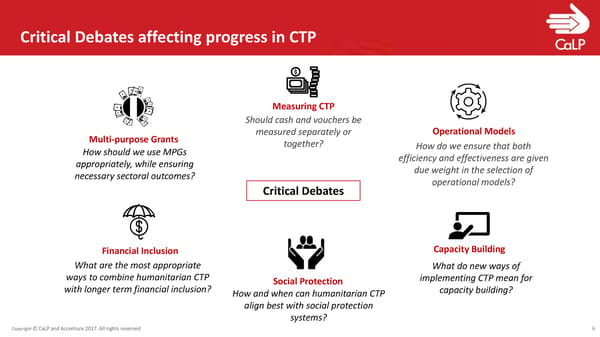
Objective 1: Ensure sufficient funding is available for cash transfer programming There is increased high level support for CTP But growth in CTP is uneven, concentrated in a few organizations 80%of practitioners agree that there has been strengthening of support for CTP 2 organizations (WFP and UNHCR) accounted for over 2/3rd of total CTP amongst donors and senior decision makers expenditure in 2016 Agencies/ donors are committing to increase their use and consideration of CTP. In Only 38% of organizations surveyed reported more than 20% growthin CTP some cases specific targets have been set, e.g. expenditure from 2015 to 2016. In a minority of cases CTP expenditure decreased 35%EU 50% WVI 2x UK DFID Improving reporting of CTP involves greater standardization Cash target for 2017 Cash target for 2020 through a Target to double its use of cash in crises by 2025 “cash first approach” Challenges to agreeing and harmonizing methodologies and systems for measuring and reporting CTP: Achieving greater scale necessitates policy commitments to be translated into ▪ Lack of common categories and definitions for measuring CTP (and other practice, requiring systemic organizational change. modalities) i.e. what should be tracked and how? ▪ Need to Invest in organizational and interagency reporting systems More aid is being disbursed as cash and vouchers Resolving key issues and finding agreement requires coordinated action across a wide range of agencies and systems $2.8bn Total Global CTP (Cash + Vouchers) amount Maintaining progress in CTP requires support in both donor and host Total Cash and Voucher aid countries in 2016 0,8 $2.8bn ▪ Only 39% practitioners surveyed believed that there is strengthening of 10.3% CTP $2bn support for CTP within the general public in donor countries of International Humanitarian 40% ▪ An appropriate communications strategy is essential to address public Assistance in 2016, compared 2015 Increment 2016 perceptions and potential concerns regarding CTP to 7.8% in 2015 Source: State of the World’s Cash Research, CaLPand Accenture Research Copyright © CaLPand Accenture 2017. All rights reserved 7
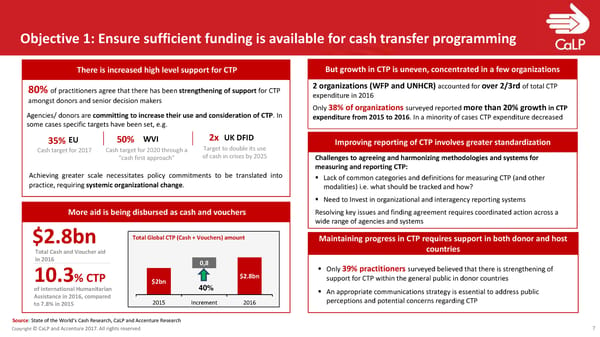
Objective 2: Ensure cash is routinely considered, alongside other tools Cash is being considered more systematically by decision makers There remain common constraints to the systematic adoption of CTP Practitioners agree that in the last 12 months, cash and vouchers have Perceived risks of misappropriation and leakage 87% been more systematically considered as a response modality ▪ Sensitivities can be higher for cash than in-kind. Donor risk appetite is important to build confidence. Further evidence is needed on effective Change is gradual, and is driven by several factors safeguards in conflict-affected areas. a. Policy and strategy commitments by senior decision makers Lackofcapacity ▪ Programme teams need to be ‘cash ready’ – in terms of expertise, b. Decision making tools – embedding tools for cash feasibility, market and systems andprocesses - to be able to translate CTP interest into action response analysis within project management processes and teams Sectoral mandates c. Institutional investment in systems and processes, staff and expertise ▪ Sectoral concerns regarding CTP are CTP tools and processes are becoming more embedded, but there are generally about ensuring effective programming in terms of sector- issues to address specific outcomes Organizations do not agree that market and response analysis have Fundingprocesses 48% become more embedded within humanitarian response ▪ There is uncertainty about the implications of increased funding Issues with the use of Response Analysis and Market Analysis for CTP, particularly MPGs, for They are undertaken inconsistently within and between organizations sector-specific funding. Response analysis is not generally revisited during implementation Lack of multi-sector assessments ▪ Multi-sectoral response analysis is considered to be an important ‘next Market analysis capacity not embedded within agencies at country level step’ by many. Challenges to date include issues of cross-sectoral Common market assessment tools are not a good match for the specificities coordination and engagement. A ‘basic needs’ approach might support of service markets better cross-sectoral integration, but further testing in practice is required Source: State of the World’s Cash Research, CaLPand Accenture Research Copyright © CaLPand Accenture 2017. All rights reserved
Objective 3: Build sufficient capacity for cash transfer programming Lack of capacity across organizations is a critical barrier to the effective Human resource capacity in CTP is improving, but gaps remain and extensive use of CTP 60% Organizations report that they do not have the capacities in place Upskilling existing staff requires suitable training as well as neededtoimplementCTP practical experience,forwhichfurtheropportunities(e.g.on-the-job Practitioners agree that their organization’s existing policies or the ones supportorsecondments)andresourcingarerequired ▪ Training can benefit from the development of more tailored materials 64% beingdevelopedwillbeeffectiveinensuringorganizational capacity and for different roles and contexts, and translation into more languages. readiness for CTP ▪ Sharing of training materials and working across organizations throughjoint capacity building approaches are favoured. Systematic investments are required to make real progress in building Capacity building strategies: organizations need to strategically identify where CTP capacity they can add most value to CTP, based on their core competencies, and use this to Organizations are building capacity, but the focus is more on strategic and technical informtheir capacity development strategy capacity than operational capacity Only 29% of practitioners believe it is easy to recruit skilled staff for Technical 79% Strategic 69% Operational 59% CTP roles, particularly for senior roles *Number in the box indicates the % of practitioners who believe that their organization is investing in respective capacities Organizations that have made greatest progress in scaling up CTP have Building capacity of local actors can generate significant benefits but is invested consistently in structured capacity building over several years. not being undertaken systematically This requires dedicated financial resourcing and leadership Only 46% of surveyed organizations reported that they support local non- governmental actors to implement cash and voucher programming It is crucial to build local cash readiness through increased investment in CTP preparedness and institutionalization Source: State of the World’s Cash Research, CaLPand Accenture Research Copyright © CaLPand Accenture 2017. All rights reserved
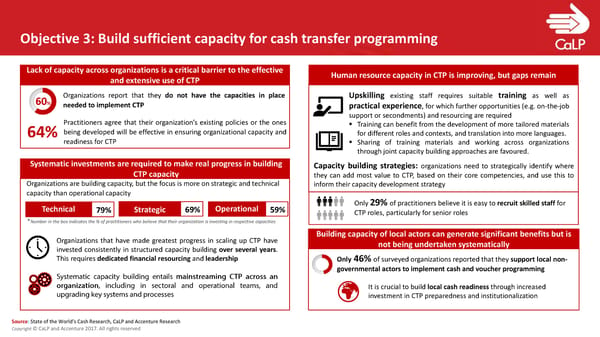
Objective 4: Ensure the quality of cash transfer programming The quality of CTP is perceived to be improving, but there is currently no common definition of what quality means for CTP 80% Practitioners believe that their organization has made 75% of practitioners believe they have the evidence they need to progress towards increasing the quality of CTP design quality CTP Common tools and standards, based on best practice, are required to Unrestricted CTP can promote choice and quality, manage quality consistently. but evidence is currently limited 81% of respondents to the practitioner survey agree that they know MPGs on their own cannot address all needs and should be about best practice tools for CTP. But CTP tools and guidance are not implementedincombinationwithotherprogrammeactivities systematically used across organizations, and are not sufficiently The use of unrestricted cash cuts to the heart of ‘putting people at the harmonizedwitheachotherorotherhumanitarianguidance centre’ of decision making There are ongoing initiatives to help address these issues, e.g. Determining the best ways for CTP to achieve sectoral outcomes, ▪ CBAProgrammeQuality Toolbox: Details the steps to be followed along including through the use of MPGs, requires constructive dialogue and the entire program cycle, in order to ensure quality of CTP collaboration across sectors ▪ Mainstreaming CTP in the new Sphere standards: Underpins the inherent multi-sector nature of MPGs and integrates CTP into relevant Effective monitoring requires the use of common indicators and sectoral technical standards processes across modalities and agencies The potential of humanitarian CTP to enhance financial inclusion Perceived lack of capacity in M&E for CTP depends on the context Greater harmoization of indicators 4/10 and outcomes can help enable Practitioners believe Whether financial inclusion should be an objective for CTP depends on comparative analyses of efficiency, humanitarian agencies have the nature of the crisis – specifically, its predictability and time horizon. effectiveness and accountability. appropriate M&E mechanisms This also needs to be resourced. in place for CTP. Copyright © CaLPand Accenture 2017. All rights reserved 10
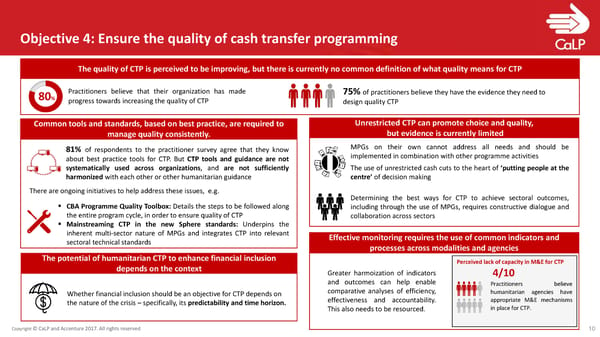
Objective 5: Strengthen coordination of cash transfer programming The coordination of CTP remains is unreliable and ad hoc, limiting the benefit realized The causes and results of this are well documented. Humanitarian actors agree on Coordination should build on existing structures and mechanisms at strategic level the need to improve cash coordination at country/response level • Growing role of governments, in some contexts Relatively few practitioners believe that predictability and quality of CTP • Widerissues about appetite for and strength of coordination coordination has increased: • Significant interest in linking to social protection systems *Indicates the % of practitioners who 30Cash Working Groupsat an operational level, organized inconsistently 41%Predictability 48%Quality agree these aspects of coordination have improved + Eachgroupcanfittogetherwithleadership&actorsineachcontext Survey respondents agree that humanitarian agencies make the best No stable or predictable basis for organisation or resourcing groups 28% use of commonmechanismsforassessment,deliveryor monitoring of - Inconsistent role, participants & link with oversight bodies CTPs Barriers to improving cash coordination not Barriers to including local actors being adequately addressed in CTP coordination Barriers include: Governments lack expertise in CTP 44% 1 Lack of progress in formalizing cash coordination in the humanitarian system Civil society organisations lack expertise 41% 2 Lack of commonly agreed processes for in CTP technical and coordination Local actors not aware of coordination 40% Lack of operational coordination on CTP mechanisms 3 assessment, delivery and monitoring Lack of clarity on CTP coordination 33% within the international humanitarian… Source: State of the World’s Cash Research, CaLPand Accenture Research Copyright © CaLPand Accenture 2017. All rights reserved
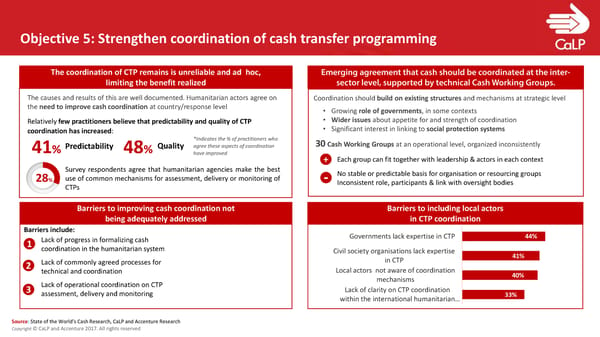
Objective 6: Strengthen the evidence base and invest in innovation The case that CTP can effectively be used at scale has been made, but significant gaps in evidence remain Collaboration in implementing CTP is increasing, but we don’t yet know which operational models are most appropriate in different contexts 80%Practitioners agree that sufficient evidence is available to make the case New operational models are developing based on considerations of for a significant increase in the use of CTP efficiency, effectiveness and accountability, in combination with Evidence gaps on the use of CTP for: specific contextual factors 1 Different contexts 2 Different sectoral outcomes 3 Use of MPGs 44% Lessthanhalfofpractitionersagreethatenoughevidenceisavailable to 4 Multi-modality / complementary programming 5 Different sub-populations informtheselection of operational models 6 Efficiency and effectiveness of different operational models Contentious issues remain: ▪ Impact on consistency of services available for different populations, and Limited evidence reduces use of CTP, but determining how to achieve coordination objectives in a specific context requires new approaches to be tested ▪ ImpactonrolesofdifferentagenciescurrentlyengagedinCTP in practice ▪ Impactonfundingcorecostsandmaintainingkeyhumanitariancapacitiesacross geographies Agencies are building the evidence base for how CTP can achieve sectoral outcomes CTP can act as a catalyst for further innovation 53% Practitioners think sufficient evidence is available about how to use cash Innovation requires an appetite for risk, and will benefit from andvouchersappropriatelyindifferentsectors increased collaboration among humanitarian agencies and the private sector. There is limited evidence in some sectors, e.g. health, nutrition, WaSH, Technology has been central to CTP, e.g. mobile money, biometrics and shelter and protection. This is being addressed through new research and digital identities. Overall, new technology has been underutilized evidencereviews Source: State of the World’s Cash Research, CaLPand Accenture Research Copyright © CaLPand Accenture 2017. All rights reserved
Priority Actions (1) Objective 1: Funding 1.1 Sustain high-level policy commitments to CTP. [GFA 1.3, GB 1.3] 1.2 Integrate CTP into organizational and inter-agency reporting systems, using common definitions. [GFA 1.4, GB 4] 1.3 Strengthen support for CTP among the public. [GFA 1.3] Objective 2: Routine 2.1 Embed contextual analysis and response analysis into humanitarian programme Consideration cycles and funding decisions. [GFA 2.2] 2.2 Identify how CTP can achieve the best results in different technical sectors and across sectors. [GFA 2.3, GB 1.6 & 1.7] 2.3 Donors should work together to ensure appropriate consideration of CTP. [GFA 2.4, GB 1.1] Objective 3: Capacity 3.1 Integrate CTP into organizations’ strategies, systems, processes and staffing [GFA 3.2] 3.2 Fund and support national organizations to build their capacity for CTP. [GFA 3.5] 3.3 Build individual competencies in CTP. [GFA 3.3] Copyright © CaLPand Accenture 2017. All rights reserved 13
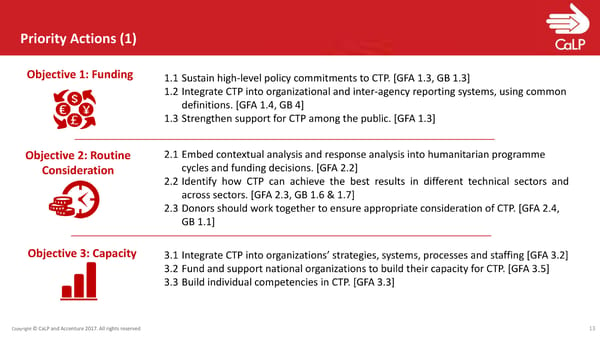
Priority Actions (2) Objective 4: Quality 4.1 Design and implement cash-based assistance to contribute as effectively and efficiently as possible to strategic outcomes [GFA 4.2, 4.3 & 4.4] 4.2 Develop common tools for managing the quality of CTP [GFA 4.1] 4.3 Integrate CTP into existing mechanisms for managing the quality of humanitarian action [GFA 4.2] Objective 5: 5.1 Integrate CTP into existing mechanisms for coordinating humanitarian action. [GFA Coordination 5.1, 5.2, GB 2.2] 5.2 Support and engage with Cash Working Groups. [GFA 5.4] 5.3 Build links between humanitarian programmes and other government/development initiatives. [GFA 5.1 & 5.3] Objective 6: Evidence 6.1 Strengthen the evidence base. [GFA 6.1, GB 1.6] & Innovation 6.2 Strengthen common platforms for building, sharing and using knowledge about CTP. [GFA 6.4 & 6.5] 6.3 Invest in innovation to achieve more for beneficiaries. [GFA 6.2] Copyright © CaLPand Accenture 2017. All rights reserved 14
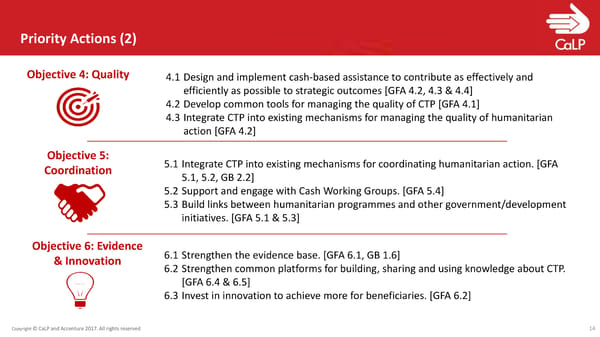
Future progress depends on two key themes and three enabling factors Two key themes Integrate CTP into all existing mechanisms of providing humanitarian aid, including: organizations’ policies, strategies, management and reporting systems, funding and programming decisions, capacity building initiatives, coordination mechanisms, standards, guidance, tools and others. Innovate and strengthen the evidence base. Trial new ways of working that generate the greatest benefits for people in crisis from the opportunities created by CTP. Develop new partnerships and stronger insights into CTP, share experience and learn together. Three enabling factors 1. Sustain the high-level policy commitments needed for the effective implementation of CTP. 2. Plan and act collaboratively. Expect to use common approaches and mechanisms for CTP at operational, national and global levels, which are implemented across organizations and existing technical sectors. 3. Support a limited amount of CTP-specific infrastructure, including platforms for collective action on CTP. Copyright © CaLPand Accenture 2017. All rights reserved 15
In Depth Case Studies Case Study Summary Nepal Examines how limited CTP capacities, institutionalization and preparedness affected the use of CTP post-earthquake, Scaling up CTP after a rapid onset disaster also highlights lessons learned for linking to social protection systems Nigeria Piloting tools and approaches for multi-sectoral cash response Zimbabwe Summarizes findings from the large scale use of mobile money to address food and nutrition security in the context Lessons from the ‘Emergency Cash First of a liquidity crisis Response’ to drought-affected communities DRC Charts the evolution of the Taking cash to scale in challenging environments Turkey Reviews learning emerging from the partnership between Turkish Red Crescent, WFP and the Government to deliver Working with host governments to deliver CTP the Emergency Social Safety Net (ESSN) during the refugee crisis Liberia Examines how CTP was used to support recovery from the Ebola epidemic, including the role of the government, and Cash at scale in response to an epidemic constraints on payment delivery options due to limited infrastructure Somalia Explores enabling factors for rapid scale up of CTP in 2017, along with challenges encountered, with a particular Rapid scale-up of cash transfer programming in focus on coordination, preparedness and the use of mobile money response to drought Lebanon Summarizes the evolution to date of different types of CTP operational models during the Syrian refugee response, Operational models for cash at scale including consortia and shared delivery mechanisms, and the learning and debates arising Source: State of the World’s Cash Research, CaLPand Accenture Research Copyright © CaLPand Accenture 2017. All rights reserved 16
Research Methodology overview Activity Objective Methodology Notes To gather opinions of practitioners in A detailed survey was rolled out to an Practitioner Survey the field of CTP and get their audience of thousands of CTP • 239 responses received spanning roles and perspective of current state of CTP practitioners via CaLP d-group, regional geographies mailing lists and newsletters To gather inputs of organisations on A brief survey was rolled out to over 40 • Captures views from 36 organisations Organisation Survey their CTP data and their perceptions of organisations over email • Major source of org-specific financial data for the current state of CTP CTP calculation To gather inputs from organisations in An interviewer facilitated the capture • 40+ interviews conducted across donors, Interviews conjunction with the organization guided responses from our contact INGOs, ICRC, governments, private sector survey point in each organisation etc. A combination of interviews and Case studies To provide detailed review of CTP in a secondary research was used to gather • 8 case studies captured in appendix particular response scenario data and analyze CTP response in different crisis situations To gather inputs from regional CTP A combination of interviews and secondary Focus group discussions practitioners and get their perspective research used to detail CTP response in • 2 FGDs concluded – Asia and West Africa of current state of CTP different crisis situations Literature review Review of the work already published in the field of CTP – to learn from the research and draw data/insights Note: Please refer to the Methodology section in Annex 1 of the State of the World’s Cash Report for further details Copyright © CaLPand Accenture 2017. All rights reserved 17
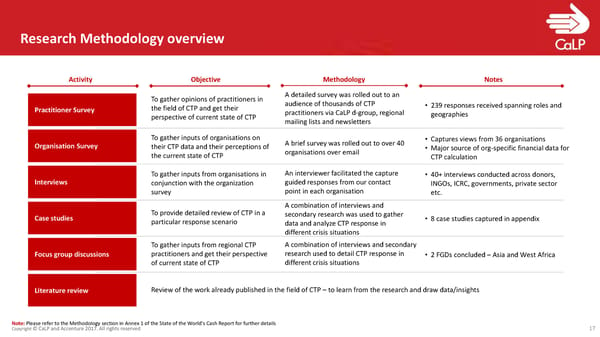

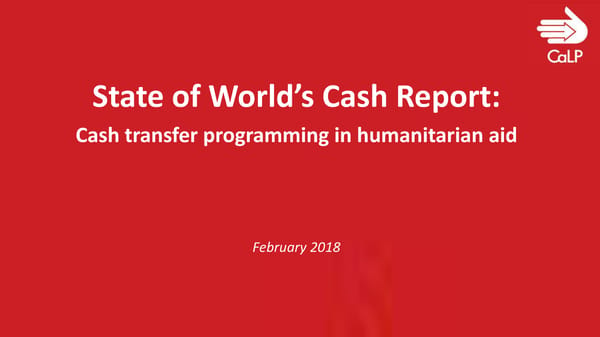
3.png)
